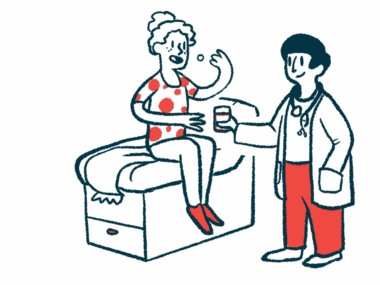Takhzyro seen to safely prevent monthly HAE attacks in adolescents
Data covers 21 patients, ages 12 to 17, treated in the HELP extension study
Written by |

Treatment with Takhzyro (lanadelumab), an injectable antibody therapy, led to a mean reduction of 94.7% in monthly hereditary angioedema (HAE) attacks in adolescents with HAE, according to findings of a Phase 3 extension study.
These results, which focused on a subgroup of 21 patients with type 1 or 2 HAE, ages 12 to 17, who participated in the HELP open-label extension study (OLE) (NCT02741596), also found that Takhzyro was well tolerated. No serious adverse events due to treatment were reported.
“[Takhzyro] provided long-term efficacy in preventing HAE attacks, was associated with clinically meaningful improvements in health-related quality of life and high levels of treatment satisfaction… in adolescent patients,” researchers wrote in their article, “Long-term prevention of hereditary angioedema attacks with lanadelumab in adolescents,” published in Annals of Allergy, Asthma & Immunology.
HAE swelling attacks tend to worsen as children reach puberty
HAE is an inherited and chronic condition that causes sudden but temporary swelling attacks, a disease symptom affecting the deeper layers of the skin.
When untreated, those with HAE experience such attacks, often without a trigger, on average once a week or every two weeks. These attacks can be severe and triggered by infections, injury, surgery, stress, or pain. They begin in childhood and tend to worsen around puberty, although attacks are known to be more frequent in adult patients.
Takhzyro, a first-line treatment which limits the production of the molecule that causes swelling attacks, is a long-term prophylaxis treatment, meaning it aims to prevent attacks by reducing their frequency, severity, and burden. While the therapy is approved in the U.S. and European Union for HAE patients starting at 2 years old, treatment outcomes in children are understudied.
Researchers analyzed subgroup results from the larger OLE study specifically to assess treatment benefits in adolescents with HAE. The data covered eight rollover patients who took part in the placebo-controlled Phase 3 HELP clinical trial (NCT02586805), and 13 newly enrolled and Takhzyro-naïve adolescents.
HELP found that among adolescents and adults with type 1 or 2 HAE, treatment with Takhzyro for six months significantly reduced the number of monthly attacks relative to a placebo.
Treatment given at a 300 mg dose every two weeks
Eighteen of the 21 teenagers had type 1 HAE, while three had type 2. The group’s average age was 14.3, and more than half (57.1%) had experienced HAE attacks located in abdominal or peripheral regions.
Rollover patients were given a single dose of lanadelumab (300 mg) at the last HELP study visit, with no further treatment until a first confirmed HAE attack. With an attack, these adolescents received Takhzyro injections at that dose every two weeks for up to 33 months.
Takhzyro-naïve patients received single treatment doses every two weeks from the beginning of the extension study until its conclusion, 33 months later.
“A considerable benefit of the HELP OLE Study design is that the inclusion of both rollover and [Takhzyro]-naïve patients enabled the evaluation of the effectiveness and safety of [Takhzyro] in a more varied patient population,” the researchers wrote.
At the study’s start, patients had a mean of 1.58 attacks per month. Takhzyro reduced this to a mean monthly attack rate of 0.11, representing an overall reduction of 94.7%.
Across the OLE’s treatment period, most days (99.1%) were free of swelling attacks, a mean of 27.7 attack-free days per month. Eight of the 21 patients (38.1%) experienced no attack during treatment.
The mean duration of the attack-free period was 18.4 months. Most Takhzyro-treated patients (85.7%) had maximum attack-free periods lasting more than one year.
Patients report gains in quality of life, satisfaction with treatment
Takhzyro treatment was well tolerated and considered safe. More than half of all patients (57.1%) reported treatment-related adverse events, mostly mild-to-moderate pain at the injection site, a common occurrence with under-the-skin injections. No treatment-related adverse events led to study discontinuation, with 95.2% of patients remaining on treatment for at least 30 months (2.5 years).
A clinically meaningful improvement was seen in patient-reported quality of life, assessed using the Angioedema Quality of Life questionnaire, with an initial score of 27.5 falling to 7.5 at the end of the study. Lower scores indicate a milder sense of disease severity.
Although both patient groups experienced what researchers deemed to be a clinically meaningful improvement in life quality, these gains were larger for the Takhzyro-naïve group than the rollover group.
The majority of those in the rollover (86.7%) and Takhzyro-naïve (90.7%) groups reported high global satisfaction with the treatment. Effectiveness and convenience were similarly highly rated by both groups.
Overall, researchers observed that many aspects of Takhzyro treatment in adolescents, from its efficacy and safety profiles to patient satisfaction, were consistent with findings among the 212 adults and adolescents treated across the OLE study, and among treated patients in the earlier, placebo-controlled HELP clinical trial.






